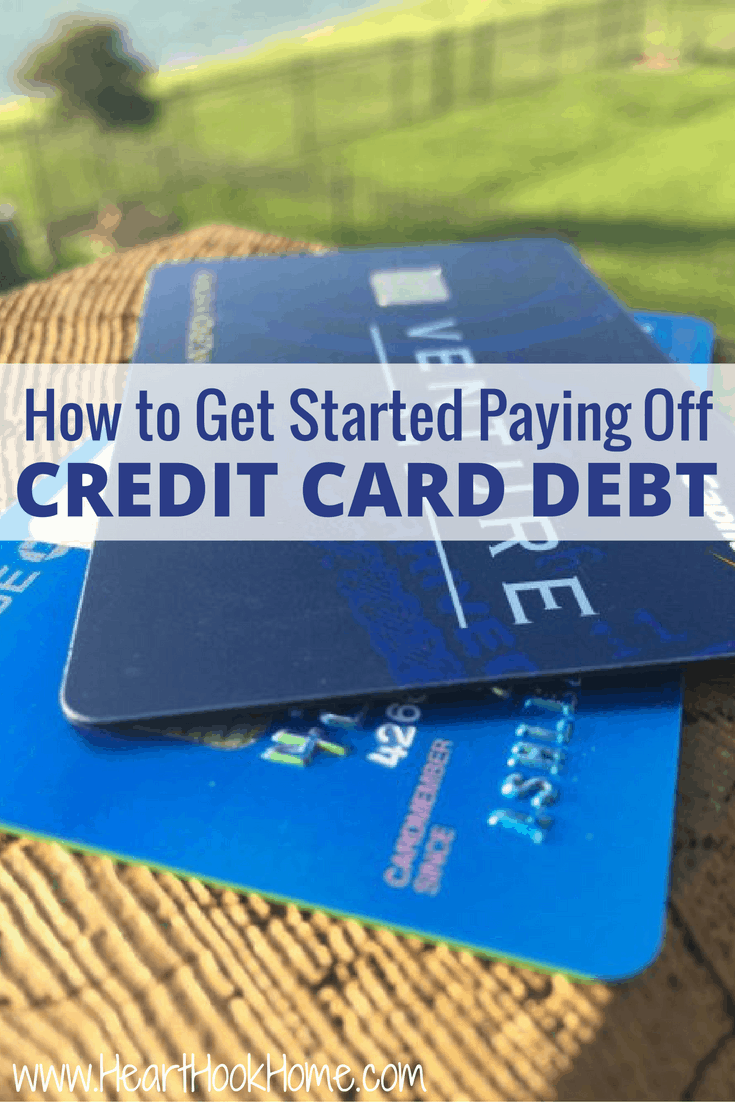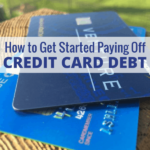Tips to Get Started Paying Off Credit Card Debt
This post may contain affiliate links, meaning that I may earn a small commission if you make a purchase. See our disclosure policy for more information.
Do you have a LOT of credit card debt? Most Americans do.
When Paul and I met, we had about $10,000 in credit card debt between us. That figure does not include his and her car payments or the house payment, store credit cards and personal loans, just a whole bunch of BAD DEBT on credit cards, eating out, buying clothes, going out with friends, Christmas presents bought on plastic etc.
We were able to pay off all of that debt, and the cars, and to start building a nest egg.

How to Get Started Paying Off Credit Card Debt
Before you even start eliminating your credit card {a.k.a. “bad”} debt, there are two main things I recommend.
1. Start an emergency fund, like yesterday.
A recent study determined that about 1/3 of Americans have little money in savings apart from retirement funds. That is a scary statistic that you do not want to be part of. While retirement accounts are crucial to living out your dreams later in life – let’s face it, the younger generations may not have much to look forward to without doing for themselves – you need financial freedom now.
While you’re young, while your kids are young, while you are working toward that goal of retirement.
You need to have emergency funds available to you now if you need new tires on the car or if Johnny breaks his leg playing football etc.
If you devote ALL of your finances to eliminating credit card debt with no money in savings, what happens when an emergency pops up? That charge goes right back on one of the credit cards you just worked so hard to pay down.
Don’t let that happen!
As Dave Ramsey suggests (and I agree!) you want to have at least $1,000 in an emergency fund. If necessary, create a separate savings account that you are less tempted to tap into. Work on getting that cushion built up, then start paying off your debt one item at a time.
When you are finished paying off ALL credit card debt, you can work on paying off your car loan(s), continue to build that savings account or make double mortgage payments on your house and then you can start contributing larger amounts to your retirement fund etc. We are in for the long haul, folks.
Building an emergency fund is not necessarily fun, and you may feel like you’re getting a whole bunch of nowhere. Remember that you are creating a platform for success. As cheesy as that sounds, it is true.
2. Get real with yourself.
OUCH! I know this is not enjoyable and perhaps downright painful (you might need a glass of wine! 😉 ), but reducing and eliminating your credit card debt WILL NOT HAPPEN if you don’t know exactly what you owe, and to whom, and at what interest rate. Know your facts, friends.
Gather your credit card statements – or login to your accounts online. Get your car loan information, and your student loan information if you’d like to include it in your debt elimination plan – although I would personally start with just credit cards, then work up to cars, then student loans, then mortgage etc.
From each statement, record your current balance, credit limit, your current interest rate and the percentage of the credit line used (you’ll need to figure that yourself). Your optimal ratio of debt to total available credit should be at or below 30%.
If I have a credit card with a $3,000 limit and I have $1,500 charged, that would be a 50% debt ratio on that card. If that same card had $1,000 charged on it, that would be 33% of the total available credit on that card.
Keeping at or below 30% on all cards will improve your credit score and help to build and maintain it as time goes along while the debt ratio numbers continue to get better and better.
Wanna save this for later?
This printable worksheet will help get you started!
KEEP THIS WORKSHEET UNTIL THE DEBTS ARE PAID!
Crossing debts off (of the ORIGINAL list) as they are eliminated is one of the best feelings in the world. Don’t deprive yourself of that, and it will remind you just how hard you have worked if there comes a bump in the road, motivating you to keep on track.
Don’t focus on the entire amount you owe. In fact, I didn’t even include that on my worksheet. While it is important to know how much debt you have accrued, dwelling on how horrible this situation is will only make you feel worse. We are all about positive changes here, no matter how quickly or slowly they take place.
The direction you’re headed is what counts, not the distance you have to travel. Now that you know where you stand, and now that you have your emergency fund ready to rock and roll, let’s get started on reducing that debt mmmkay?
There are two generally accepted methods to eliminating credit card debt. Some recommend tackling the account with the highest interest rate first, while others recommend paying off the account with the lowest balance first.
3. Tackle one account at a time, do not try to pay them all off at once.
It is much more effective to eliminate ONE sum before moving on to another than to pay just a little more than minimum on ALL cards you possess. If there is one account that has a lower balance that may be paid off with a few months of diligent work (and less eating out, less shopping, cutting back in general etc) then yes, I’d start with that one first.
If all of your cards are hovering around the same balance, then start with the one with the highest interest rate first.
It is costing you the most money. Ultimately, you’ll want to get that very first account paid off as quickly as possible, whether it is the account with the lowest balance or the highest interest rate, if for no other reason than it builds morale.
*high five*
Pay as much as you can on that FIRST card without dipping into your emergency fund savings.
IMPORTANT! Continue to pay the minimum on ALL other accounts as usual. While you’re paying that first account off, you want to keep in the good graces of the others.
No matter if you pay the lowest balance OR the highest interest rate first, the next step is just as important as the first!
When your first debt is paid off, it will be very tempting to take that newly freed up money and go splurge. The best decision is to take that entire amount (okay a least 90% of it 😉 ) and apply that ON TOP of the minimum payment on the NEXT card you’d like to tackle.
Let’s say that the minimum payment on the second card on your list is $25 per month. You were paying $475 total on that FIRST card to pay it off, so now combine those two payments and pay $500 on the total balance of the second card on your list.
When you’re done with the second card, apply that $500 + the minimum payment of the next card to the third card’s payment. Trust me, when you get to this point they pay off FAST. Getting started is the most difficult.
Disclaimer: Always use our advice at your own discretion. You are ultimately responsible for your debt and your credit score, and your own finances in their entirety. Of course.
See more Finance Tips and Tricks:
Get Credit Quick: 5 Do’s and Don’ts to Boosting Your Credit Score
Boosting Your Credit Score – Keep your Debt to Available Credit Ratio Low + Oldest Cards Remain OPEN!
How We Joined the 800+ Credit Score Club
Six Reasons You Should *EXCLUSIVELY* Use Credit Cards
Ways to Free Up Money Immediately (When You’re Feeling Broke)







